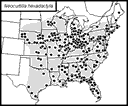




|

|

|

|
| map | female | female | forefemur & foretibia |

|

|

|

|
| hind tibia (outside) | hind tibia (outside) | left foreleg | left foreleg |

| Song at 25°C: | Rhythmic, low-pitched chirps from the ground at ca. 2-3 ch/s, 8-16 p/ch, 1.7 kHz, 58 p/s. No acoustical burrow is known. Calling occurs afternoons as well as evenings. Neighbors do not synchronize or alternate their chirps. The courtship song of the southern mole cricket is similar but higher in pitch (2.8 kHz) and chirp rate (3-4 ch/s). |
| Identification: | Basal projection of fore femur lobe-like; hind tibia with eight spines at apex, four on inside and four on outside. Length 19-33 mm. |
| Similar species: | G. major is 35-50 mm long and basal projection of femur are blade-like. G. gryllotalpa is 36-46 mm long and its hind tibiae are armed above with three or four long spines. |
| Habitat: | Margins of lakes and streams; low, mucky ground. |
| Season: | Adults occur nearly year-round. Song period July-Sept. in southern Michigan; July-Nov. at Raleigh, N. Car.; and Jan.-Aug. at Gainesville, Fla. In central Florida, northern mole crickets have a one year life cycle and overwinter as adults. In North and South Carolina the life cycle is two years, with the first winter passed as mid juveniles and the second as adults. Farther north, for example, in Michigan, more than two years may be required, but no one has investigated. |
| Remarks: |
In the Carolinas this species may mate in the fall (when singing occurs) with the females storing the sperm until they lay eggs the following spring. In Florida, most singing is in the spring and probably immediately precedes egg-laying.
Individuals from peninsular Florida average smaller than those from farther north. This difference may be indicative of a one-year life cycle in the south compared with a two- or three-year life cycle in the north. C.E. Smith studied a wasp (Larra analis) that hunts northern mole crickets by entering their burrows. Unless thwarted by the sticky slime ejected by the mole cricket, the wasp paralyzes the mole cricket with stings and attaches an egg to it. The mole cricket quickly recovers from the attack and resumes normal activity, but the egg becomes a larva that feeds on and eventually kills its host. Northern mole cricket males apparently call from closed burrows rather than from openings that direct the sound upward. Such calling is safer than calling at the bottom of an open horn and may be more effective in attracting flightless females, which must travel on the surface or through the burrow system to reach the calling male. In museum collections about half the females have long wings, but many of these are individuals that had flown to light, thereby biasing the sample in favor of long wings. This species occurs in South America, but may not be native there. Its abundance in temperate South America, as judged from light trap catches, is like our pest mole crickets rather than our populations of northern mole crickets. On the other hand, our pest mole crickets are much less abundant in their South American homeland than they are in their adopted home. This switch in roles may be due to the introduced mole crickets leaving specialized natural enemies behind. In keeping with this, Larra analis attacks northern mole crickets, but not our pest species, and does not occur in South America. [Our pest species are attacked by Larra bicolor, a South American species that has been introduced to North America as a biological control agent.] |
| More information: |
Family Gryllotalpidae. |
| References: | Baumgartner 1910a, 1910b; Castner & Nation 1986; DeWitt 1978; Fulton 1951; Hayslip 1943; Semlitsch 1986; Smith 1935. |
| Nomenclature: | OSF (Orthoptera Species File Online). |

|

|